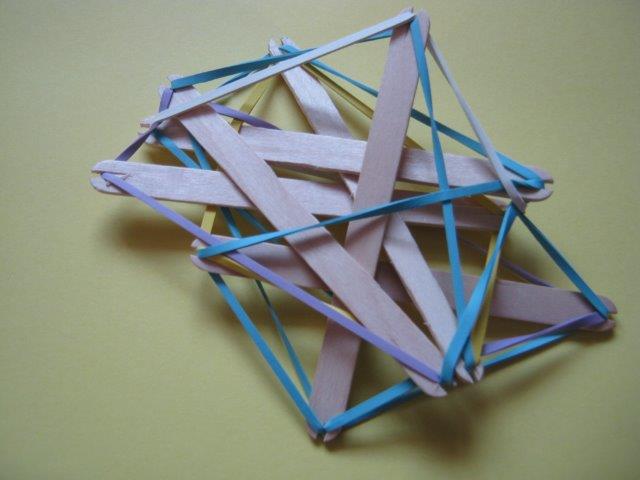
 | Opharmia | home |
|
One way of approaching the problem of protein folding is to consider simpler systems, in order to understand the shape of an energy landscape, and the problems
which a system has in approaching the minimum. Useful work has been done on systems such as Morse Clusters and
Lennard-Jones clusters.
I felt, however, that it would be could to have a system with a physical model, where I could feel the forces involved. It would be very difficult to make a model of Morse or Lennard-Jones potentials, since macroscopic objects don't have the property of repulsion close to and attraction further away that is required. One possiblity would be a virtual reality system with some sort of Haptic interface but that is a long term project. To create something (hopefully) simpler my thoughts turned to Tensegrity structures. These are 3 dimensional structures with struts in compression held together by links in tension. Using rubber bands as the links means that it is possible to create a structure with an energy landscape. This would be something that could be held in the hand, but also modelled using programs which investigate energy landscapes. The following images were created using a custom potential and Python Energy Landscape Explorer. I decided to start with a simple system, which would only have one energy minimum.
 Creating an actual model, however, is a different matter. This isn't because the bands follow Hooke's law
(as far as I can tell the force is more like that in the second image above), it's because of the problems of getting all of
the bands in the right place. Using lolly sticks seemed like a good option, not because I eat a lot of ice lollys, but because they are available from craft stores.
It looks like I'm going to need to consider a different option if I'm to hope to create a structure large enough to have multiple equilibrium points.
Creating an actual model, however, is a different matter. This isn't because the bands follow Hooke's law
(as far as I can tell the force is more like that in the second image above), it's because of the problems of getting all of
the bands in the right place. Using lolly sticks seemed like a good option, not because I eat a lot of ice lollys, but because they are available from craft stores.
It looks like I'm going to need to consider a different option if I'm to hope to create a structure large enough to have multiple equilibrium points. Your task - should you choose to accept itSo this is where you come in - can you do better. What are the best ways to create large tensegrity structures with elastic links. If you come up with a good structure, why not post it on twitter with the hashtag #OpharmiaTensegrity (you can do this via the panel below if you have a twitter account, although I think that you will need to open Twitter in it's own page in order to post a picture). No prizes I'm afraid, but I look forward to seeing what you can do. |
Note
The above Twitter feed is a combination of tweets for two websites. You can find the tweets for Opharmia.org alone here
|